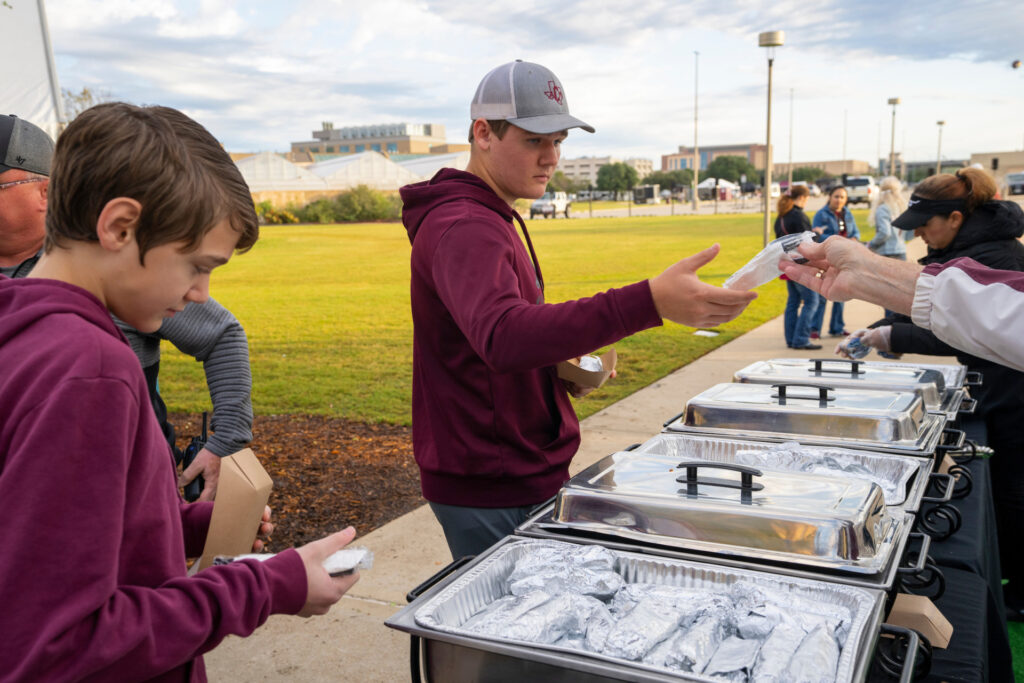Tailgate food safety before, during and after a game
A tailgate party should be full of fun, not foodborne illness
Now that football season is officially here, Texans are spending plenty of time tailgating. Whether it be cheering on a local school’s six-man team, returning to an alma mater for a longstanding rivalry or attending a stadium game, football and the activities surrounding it are an integral part of fall for most Texans.
Texas A&M AgriLife Extension Service’s Rebecca Dittmar, program specialist for the food safety education program, wants people to understand the true importance of food safety when tailgating. Because while everyone is excited to get a touchdown, no one is excited to come down with a touch of food poisoning or worse.

“Food safety best practices during a tailgate, or any outing where food is transported and served, will reduce the chance of foodborne illness,” Dittmar said. “Texans should have food safety in mind during all stages of their tailgating festivities.”
Temperature matters
Texans know over the course of the football season you can go from wearing a T-shirt and shorts at a game to needing multiple layers, which include a jacket, hand warmers and a blanket or two for good measure.
When it comes to food at a tailgate, the last thing you want is a range of temperatures. To stay safe, hot food must stay hot and cold food must stay cold. However, keeping food at the proper temperature takes some advance planning. Never assume a cooler is cool enough or an insulated bag will be hot enough to keep your food safe.
The “danger zone” for food is temperatures between 40 and 140 degrees; Dittmar said harmful bacteria grows most rapidly in this range.
Keep it clean and avoid cross-contamination
Keep foods in appropriate containers and separate from one another to prevent cross-contamination. Pack enough serving utensils for each individual dish.

Make sure all produce is cleaned in advance.
“You should scrub produce with a designated fruit and vegetable cleaning brush under cool water,” Dittmar said.
Make sure soap, hand sanitizer and water are available for washing hands at the game.
Before the game
When shopping and preparing food and beverages for a tailgate, Dittmar stressed the importance of putting safety first throughout the process.
- Keep raw meat separate from other ingredients not only in your shopping cart but also at home and in your cooler.
- Never pack partially cooked meat. It needs to be fully cooked in advance or raw and cooked onsite. Partially cooking meat does not fully kill bacteria that can lead to illness.
- Wrap cooked food well and place it in an insulated container until it’s ready to be served.
- When defrosting meat or other food items, allow enough time to thaw under refrigeration.
During a tailgate
- Make sure food for the grill goes directly from the cooler to the grill. Don’t let anything sit out.
- Uncooked perishable foods such as hot dogs, burgers, poultry and cold salads should be kept in a well-insulated cooler at 40 degrees or below.
- Hot food should be kept hot – at or above 140 degrees.
- Poultry and hot dogs should be cooked to a 165-degree internal temperature, and hamburgers to 160 degrees. All beef, pork, chops and roasts should be cooked to at least a 145-degree internal temperature.
- Make sure you have a properly calibrated meat thermometer to take with you and use it on meat. Meat may look done, but that is no guarantee the minimum internal temperature has been reached and all bacteria are killed off.
- Cooked foods should also be allowed to “rest” for 3 minutes before serving.
- Once cold food is served, it should not sit out for longer than two hours, and if the temperature is above 90 degrees the maximum exposure time should be under one hour.

After the game
- Unpack the cooler as soon as possible after returning home.
- Refrigerate any leftover meats and foods that remained sufficiently cold while in the cooler and discard any foods that have become too warm.
- If there is any doubt, throw it out.
- Clean your cooler out. A cooler is a breeding ground for any bacteria left behind.
- All serving containers, utensils, plates and cups, anything that was in contact with anything raw or cooked, should receive a thorough washing. Don’t forget to clean grill tools, too.
“With a little advance planning and an understanding of food safety, you can enjoy your tailgate and feel good knowing you are protecting your friends and family from foodborne illnesses,” Dittmar said.


